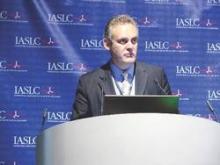DENVER – Adding the antiangiogenic antibody bevacizumab to chemotherapy improves outcomes in patients who have unresectable mesothelioma, with little downside, according to results of MAPS (the Mesothelioma Avastin Plus Pemetrexed-Cisplatin Study).
Median overall survival in the multicenter randomized phase III trial was 2.75 months longer for patients given bevacizumab in addition to the doublet of pemetrexed plus cisplatin, first author Dr. Arnaud Scherpereel reported at a world conference on lung cancer. This benefit was achieved with only a small increase in the rate of grade 3 or 4 toxicity and no detriment to quality of life.
“We feel that the treatment of pemetrexed-cisplatin with bevacizumab is a new treatment paradigm for mesothelioma patients eligible for bevacizumab and not candidates for curative surgery. And I think that most of them may be eligible for this drug because these patients are not so often smokers and [have] lung conservation, they have less comorbidities,” he said. “Perhaps this treatment may be accepted as a new standard of care for these patients.”
The control arm had much better survival than had been seen historically with this chemotherapy, noted Dr. Scherpereel, who is head of the pulmonary and thoracic oncology department and a professor at the University Hospital (CHRU) of Lille, France. This may have been because of the trial’s eligibility criteria, chosen to ensure that patients could receive bevacizumab, or to the facts that patients had to be fit enough to undergo thoracoscopy and that some received pleurodesis before enrollment.
Bevacizumab benefit may therefore differ in other patients, he acknowledged. “We will see in the real life. I hope first to have the drug [available] for this indication,” he said an the conference sponsored by the International Association for the Study of Lung Cancer.
Press conference moderator Dr. James R. Jett, conference cochair and a professor of medicine at National Jewish Health in Denver, noted that pemetrexed-cisplatin remains the standard of care in the United States. “We don’t have bevacizumab as the standard, but this [trial] may very well change that,” he said.
He wondered if the unusually good outcomes in the control arm were related to earlier diagnosis, but said that regardless, bevacizumab still showed a benefit. “I think the main message here is that it’s important to do concurrent controls because if we were comparing to a historic control, it would be very difficult,” he said.
MAPS was sponsored by the French Cooperative Thoracic Intergroup and was open to patients with mesothelioma who were not candidates for surgery and had not received chemotherapy. Those who had pleural effusion were allowed to undergo a talc pleurodesis at the time of diagnostic thoracoscopy.
A total of 448 patients were randomized to open-label cisplatin and pemetrexed, with versus without bevacizumab (Avastin). The bevacizumab group additionally received the drug alone as maintenance therapy after completing chemotherapy. Cross-over was not allowed.
With a median follow-up of 39.4 months, the bevacizumab arm had better median overall survival (18.82 vs. 16.07 months; hazard ratio, 0.76; P = .015)—the trial’s primary endpoint—and progression-free survival (9.59 vs. 7.48 months; hazard ratio, 0.61; P less than .0001).
“Usually the progression-free survival in the trials with best medical treatment was between 6 and 7 months,” Dr. Scherpereel pointed out. Similarly, “the best [overall survival] results with the standard treatment is close to 13 months.”
“There was no significant difference between the two arms in the percentage of drug delivery or the percentage of patients having second-line treatment which could explain the increase of survival in the bevacizumab arm,” he reported.
The proportion of patients experiencing grade 3 or 4 toxicity was higher with bevacizumab (71.2% vs. 62.1%; P = .04), largely because of more nonhematologic toxicity such as hypertension and venous thromboembolism. However, this additional toxicity was manageable, according to Dr. Scherpereel.
Furthermore, in terms of quality of life measures, patients in the bevacizumab arm had a greater improvement in fatigue from baseline (P = .046) and scores for other measures did not differ between arms.
“We did not find some predictive clinical or biological marker [of bevacizumab benefit] for this study,” he said. In particular, patients’ pretreatment levels of vascular endothelial growth factor (VEGF) did not identify a group more likely to benefit. But an ongoing companion study is still evaluating other biomarkers, such as mesothelin and endocan, he added.
Dr. Scherpereel disclosed that he and coinvestigators had affiliations with Roche and other companies. Roche supplied bevacizumab and a research grant for the biomarker studies.


